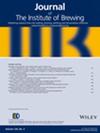挑衅:啤酒长时间的成熟是未经证实的好处
IF 2
3区 农林科学
Q3 FOOD SCIENCE & TECHNOLOGY
引用次数: 0
摘要
酿造方法充满了教条主义的坚持,认为某些技术与提供高质量的产品毫无疑问有关。在这些信念中,有一种坚持不懈的信念,那就是长时间的成熟(或“调节”)后发酵。从历史上看,这些贮藏技术的理由是允许固体沉淀,碳化,风味成熟和去除冷雾实体。随着科学技术的进步,毫无疑问,固体和冷霾前体可以在短时间内处理,而不需要长时间的处理。同样,完全有可能提供特定水平的碳酸化,而不需要通过酵母作用引入所有的二氧化碳。然而,仍有许多人认为,碳酸化的性质取决于所采取的方法。这是笔者提出的研究方向之一。对碳酸化的感知主要不是由于上颚上的气泡释放,而是通过对碳酸的检测。这种形式的气体的可用性是否取决于碳酸化的模式,以及啤酒中多肽对碳酸的吸附在多大程度上起作用?就口味而言,啤酒的倡导者坚持认为,需要处理邻近的二酮、乙醛和硫化氢。然而,所有这些都可以通过注意初级发酵来控制。然后,熟化的支持者坚持认为,啤酒中有一种理想的非挥发性物质释放,这种物质被认为有利于啤酒的平衡和口感。这些物质包括氨基酸和核苷酸。然而,在作者看来,这些物质和pH值大幅增加的最可能的解释是酵母的自溶。这一点,再加上游离氨基氮增加和pH值升高对生物稳定性、风味稳定性和泡沫等方面的不利影响,应该让任何酿酒商相信,避免啤酒与酵母长时间接触是有道理的。事实上,在很少或没有自溶的条件下,研究非挥发性物质变化的代谢组学方法显示,任何实体都没有可检测到的变化。作者愿意相信,在啤酒储存过程中,有尚未确定的物质(无论是通过活酵母的作用还是通过酵母自溶)被开发出来,这些物质可以通过健全的感官调查证明有利于啤酒的味道。也许我们在这里寻找的是日语术语kokumi:“丰富的味道”。这被认为是由γ-谷氨酰肽提供的,除其他外,这些是在酵母提取物中发现的。这就是作者推荐的第二种实验方法。本文章由计算机程序翻译,如有差异,请以英文原文为准。
Provocation: prolonged maturation of beer is of unproven benefit
Approaches to brewing are suffused with dogmatic insistence that certain techniques are unequivocally linked to the delivery of quality products. Amongst these belief sets is the perseverance with prolonged maturation (or ‘conditioning’) times post-fermentation. Historically the justification for these lagering techniques was to allow settling of solids, carbonation, flavour maturation and removal of chill haze entities. As science and technology have advanced it is unequivocally the case that solids and chill haze precursors can be dealt with in short order and without the need for lengthy treatments.
Equally it is perfectly possible to deliver specified levels of carbonation without the need for all the carbon dioxide to be introduced via yeast action. However, there remain many who feel that the nature of carbonation differs depending on which approach is taken. Herein lies one of the research areas that the author proposes. The perception of carbonation is not primarily due to bubble release on the palate, but rather is through the detection of carbonic acid. Is there a difference in the availability of this form of the gas depending on the mode of carbonation and to what extent does the adsorption of the carbonic acid on polypeptides in the beer have a role to play?
In terms of flavour, the advocates for lagering insist that there needs to be a handling of vicinal diketones, acetaldehyde, and hydrogen sulphide. However, all of these can be controlled through attention to primary fermentation. Then, the proponents for maturation insist that there is a desirable release of non-volatile materials into beer, which substances supposedly benefit the balance and mouthfeel of the lager. These include amino acids and nucleotides. It seems to this author however that the likeliest explanation for the greatly increased levels of these materials and of pH is autolysis of yeast. This, together with the disadvantageous impact of increased free amino nitrogen and higher pH on aspects such as biological stability, flavour stability and foam, should convince any brewer that there is a sound argument for avoiding the prolonged contact of beer with yeast. Indeed, a metabolomic approach to studying changes in non-volatile substances under conditions where there is little or no autolysis, revealed no detectable changes in any entity.
The author is open to being convinced that there are yet unidentified materials that are developed (whether through the action of viable yeast or by yeast autolysis) as beer is stored, substances which can be proven through sound organoleptic investigation to benefit the flavour of beer. Perhaps the Japanese term kokumi is what we are looking for here: ‘rich taste’. This is believed to be afforded by γ-glutamyl peptides and, inter alia, these are to be found in yeast extracts. Herein lies the second experimental approach that the author recommends for pursuit.
求助全文
通过发布文献求助,成功后即可免费获取论文全文。
去求助
来源期刊

Journal of The Institute of Brewing
工程技术-食品科技
CiteScore
6.20
自引率
7.70%
发文量
25
审稿时长
6 months
期刊介绍:
The Journal has been publishing original research for over 125 years relating to brewing, fermentation, distilling, raw materials and by-products. Research ranges from the fundamental to applied and is from universities, research institutes and industry laboratories worldwide.
The scope of the Journal is cereal based beers, wines and spirits. Manuscripts on cider may also be submitted as they have been since 1911.
Manuscripts on fruit based wines and spirits are not within the scope of the Journal of the Institute of Brewing.
 求助内容:
求助内容: 应助结果提醒方式:
应助结果提醒方式:


